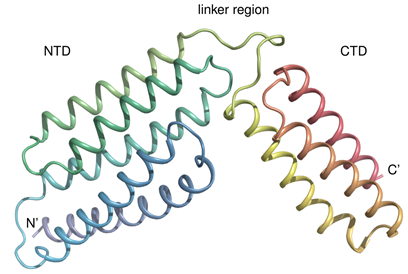USTC Biologists Identified the Structure of the Streptococcus Agalactiae CAMP Factor [2018-06-16] Streptococcus (S.) agalactiae (contains the CAMP factor) is the toxin that could cause serious health problems. USTC biologists have, to the first time,
[
Streptococcus (S.) agalactiae (contains the CAMP factor) is the toxin that could cause serious health problems. USTC biologists have, to the first time, identified the structure of the S. agalactiae CAMP factor using X-ray diffraction technique. The team has also revealed the molecular mechanism of S. agalactiae’s co-hemolytic activity based on the obtained structural information. This collaborative work was led the by Prof. JIN Tengchuan from the School of Life Sciences and Medical Center at USTC and Prof. Michael Palmer from the University of Waterloo.
As for the structure of S. agalactiae CAMP factor, the researchers reported the structural fold composed of 5+3 helix bundles, where the N-terminal 5 helix bundle is believed to be responsible for membrane permeabilization and the C-terminal 3 helix bundle is likely responsible for host receptor binding. Besides, the C-terminal domain is revealed to inhibit the activity of both full-length toxin and its N-terminal domain. The researchers also observed that the linker region has a conserved DLxxxDxAT sequence motif, which is required for CAMP factor’s co-hemolytic activity. The results help clarify the molecular mechanism of S. agalactiae’s co-hemolytic activity.

The overall structure of the group B streptococcus CAMP factor / Images from Prof. JIN Tengchuan
The research article entitled “Crystal Structure of the Streptococcus Agalactiae CAMP Factor Provides Insights into its Membrane-Permeabilizing Activity” was publish in the Journal of Biological Chemistry on June 8, with Prof. JIN Tengchuan and Dr. Eric Brefo-Mensah as the first authors and Prof. JIN Tengchuan as the correspondent.
The research was supported by the Fundamental Research Funds for the Central Universities, the 100 Talents Programme of the Chinese Academy of Sciences, the National Natural Science Fund for Young Scholars, the China Postdoctoral Science Foundation and the Canadian Natural Sciences and Engineering Research Council.
Research paper link: http://www.jbc.org/content/early/2018/06/08/jbc.RA118.002336.abstract
Back
